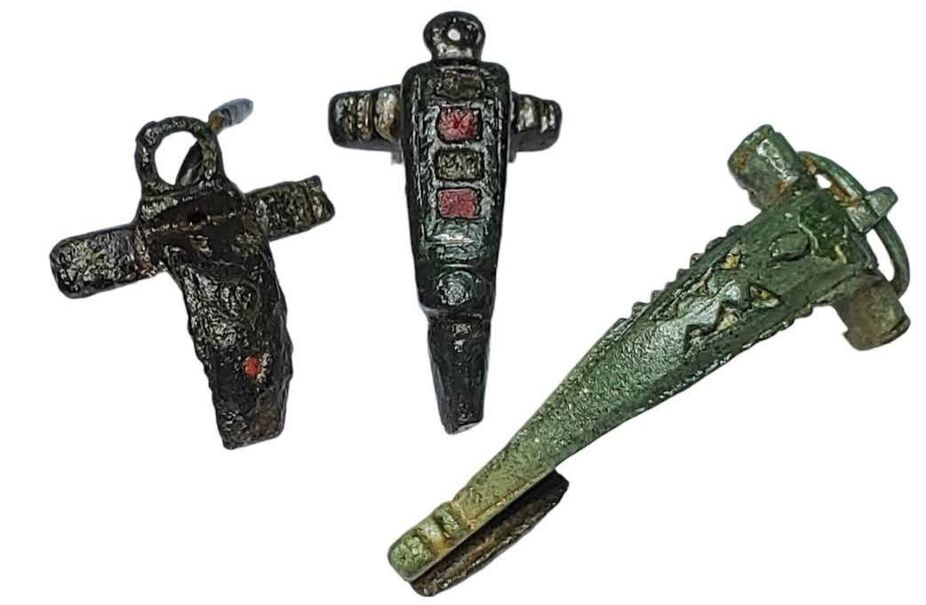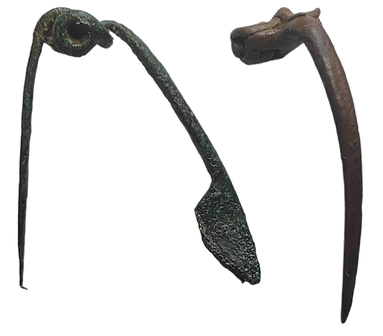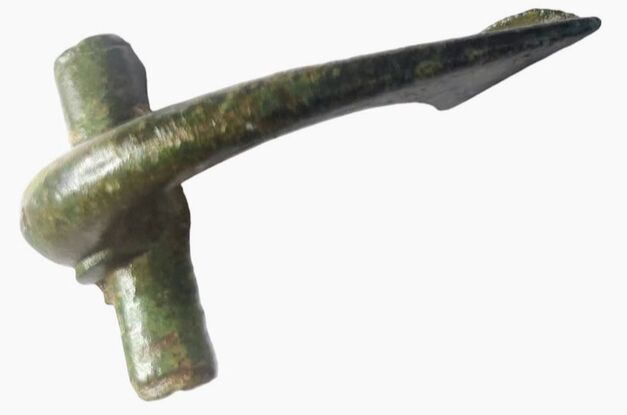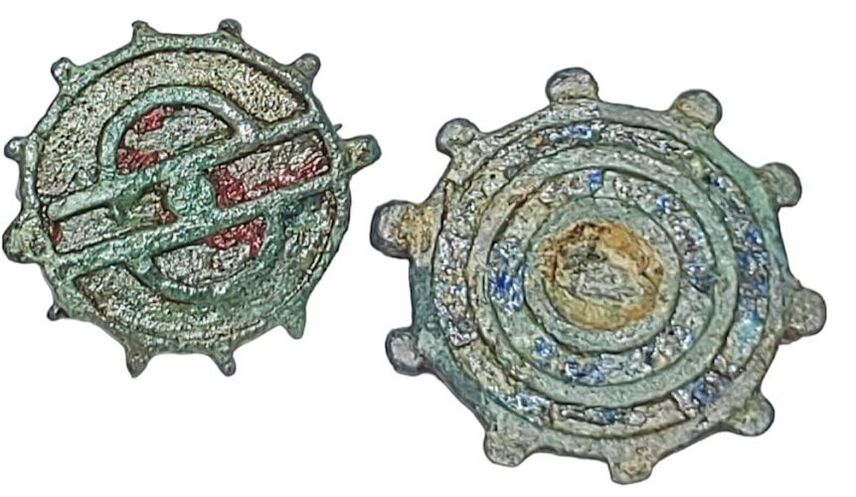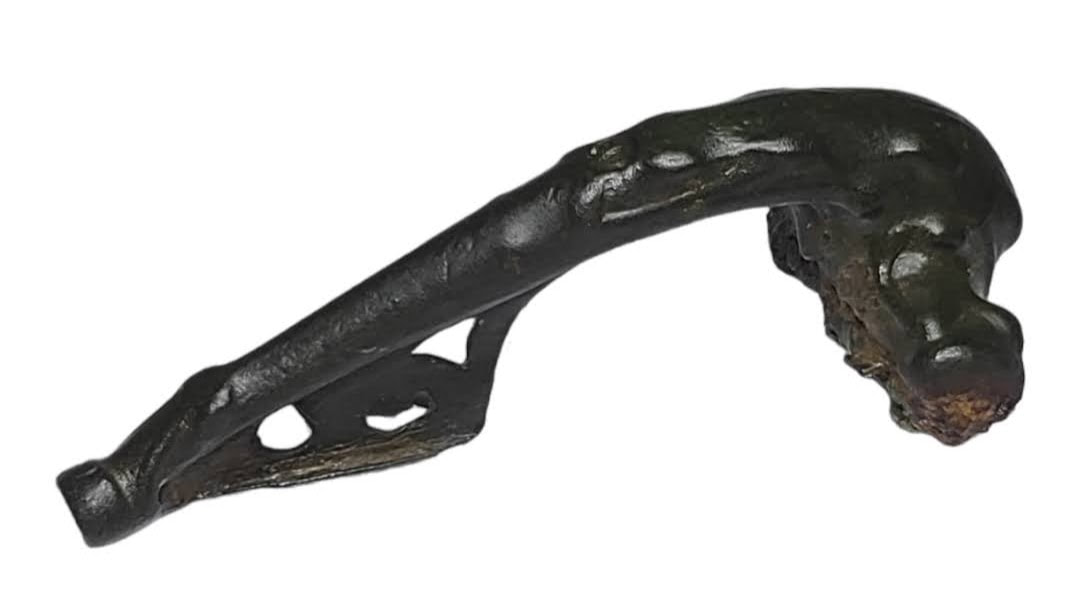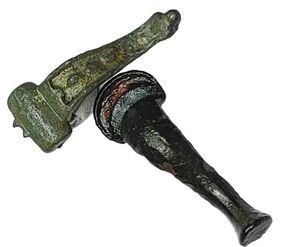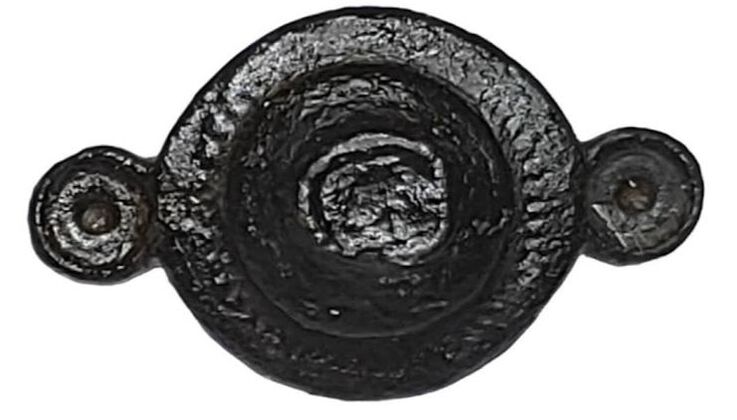Roman Brooches at Hazelbury Text and photos Steven Simmons August 2023
In the last issue, I explained how I had been given permission to detect finds in the grounds of Hazelbury Manor and the area around. I am keen to record the findings to add to the history of the area. This article is about the a very extensive number of Roman brooches found there.
Brooches are a regular find of archaeologists because they were in common use before, during and after the Roman period in Britain. Without buttons or zips, fibulae (brooches) were the usual method of fastening clothing garments used by both men and women and particularly useful in the colder climates of Northern Europe for fastening heavier material. They were used to secure a single item of material, two pieces of cloth, and in later periods as a decorative item. To begin with, many brooches were made locally but were increasingly imported when they became more elaborate. As a result, they have often been used for dating purposes, becoming some of my favourite detectorist finds in the area around Hazelbury.
Early Brooches
Brooches in Britain are found from around the second century BC, meaning that they had already been around for two hundred and fifty years when the Roman invasion took place in 43AD. They continued to be developed and manufactured in Britain for another two hundred and fifty years. Although they are usually described as Roman brooches, the term is somewhat misleading and they are more accurately described as Iron Age and Romano-British brooches. Brooches are not exclusive to Britain and a certain number of Continental brooches made it to our shores, particularly in the South East.
Brooches are a regular find of archaeologists because they were in common use before, during and after the Roman period in Britain. Without buttons or zips, fibulae (brooches) were the usual method of fastening clothing garments used by both men and women and particularly useful in the colder climates of Northern Europe for fastening heavier material. They were used to secure a single item of material, two pieces of cloth, and in later periods as a decorative item. To begin with, many brooches were made locally but were increasingly imported when they became more elaborate. As a result, they have often been used for dating purposes, becoming some of my favourite detectorist finds in the area around Hazelbury.
Early Brooches
Brooches in Britain are found from around the second century BC, meaning that they had already been around for two hundred and fifty years when the Roman invasion took place in 43AD. They continued to be developed and manufactured in Britain for another two hundred and fifty years. Although they are usually described as Roman brooches, the term is somewhat misleading and they are more accurately described as Iron Age and Romano-British brooches. Brooches are not exclusive to Britain and a certain number of Continental brooches made it to our shores, particularly in the South East.
|
The earliest brooch found at Hazelbury dates to the end of the Iron Age, a period known as the La Tene III. It is a simple brooch made from one piece of wire, twisted to create a spring, with a catch plate fashioned at one end and a pin at the other. In design it showed symbolic animal forms in a curvilinear shape. This design made the brooch similar in many ways to a modern safety pin.
Next there is what is known as a Colchester brooch, named after the large quantity found at Colchester, many of which were intentionally buried when Boudicca and her Icene tribe razed the town in 60AD. Made from two pieces they are not dissimilar to the earlier La Tene III brooch but with a central pin to hold the spring. They are dated to the early part of the first century AD. |
Other brooches found at Hazelbury which date from the first century include two Colchester derivative brooches, one of these being the Polden Hill type. The name comes from the Polden Hills in Somerset and they form the most common type found in the South West. The other is a direct descendant of the Colchester commonly worn by Boudicca's Icene.
Notably, there is a Harlow Spring brooch commonly worn by the Catuvellauni and Trinovantes tribes, who both participated in Boudicca's revolt at Colchester. My finds also included an Aucissa and a Birdlip brooch, both continental imports. Also, there was a hinged T-shaped brooch and a Knee brooch of a variety typical of military use.
Later Decorative Brooches
The second century brooches made more use of enameling as decoration. Some would have been dipped in molten tin giving them a look not dissimilar to modern chrome plating. I found a Polden Hill brooch and three partial hinged enameled bow brooches with loops for holding a chain or ribbon. These would have been predominantly worn by women in pairs as much decorative as functional. Completing the second century brooches there were two decorative enameled hinged disc brooches, as shown below.
The second century brooches made more use of enameling as decoration. Some would have been dipped in molten tin giving them a look not dissimilar to modern chrome plating. I found a Polden Hill brooch and three partial hinged enameled bow brooches with loops for holding a chain or ribbon. These would have been predominantly worn by women in pairs as much decorative as functional. Completing the second century brooches there were two decorative enameled hinged disc brooches, as shown below.
My finds include a couple of third century knee brooches (the term describes the shape rather than the function). They both appear to be based on the Polden Hill spring mechanism and follow the fashion of high decoration and enameling. There is also a partial umbonate brooch which could be slightly earlier or later. Unfortunately, during the Roman occupation grave goods often did not include brooches making accurate dating difficult. There is also a small continental umbonate plate brooch
Above Left: Polden Hill knee brooches from the 3rd century AD and Right: 3rd century knee brooch
|
After the third century British Romano brooch production dwindled in favour of continental imports of Trumpet and Crossbow brooches, very few of which made it this far west. However, my finds include a small third century Continental Umbonate (round knob) plate brooch with settings for two stones and some enameling none of which survive. Left: Continental Umbonate brooch. |
Conclusion
The volume of brooches found at Hazelbury in a confined area is quite remarkable. They are strongly suggestive of a site occupied over a long period of time. But until further domestic settlement can be established, this must remain uncertain. They may originate with passing travellers from the nearby Roman road but this seems unlikely as it is a good few hundred meters away. Alternatively, the finds may indicate a link road from the villa at Box to the Roman road which passed through Hazelbury. Whatever the ultimate conclusion, these finds help to date the longevity of usage of the area of Hazelbury.
The volume of brooches found at Hazelbury in a confined area is quite remarkable. They are strongly suggestive of a site occupied over a long period of time. But until further domestic settlement can be established, this must remain uncertain. They may originate with passing travellers from the nearby Roman road but this seems unlikely as it is a good few hundred meters away. Alternatively, the finds may indicate a link road from the villa at Box to the Roman road which passed through Hazelbury. Whatever the ultimate conclusion, these finds help to date the longevity of usage of the area of Hazelbury.
